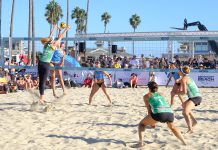You can hear it said all over town by young and old, skilled and unskilled surfers: “Hope the surf comes up,” or, “There’s a big swell coming our way,” and even, “Pray for surf!”
The excitement that spreads throughout the surf community by such visions can be felt anywhere surfers meet. To the outsider it may seem that we all wish we could ride 10- to 12-foot surf every day, but the reality of the situation is that when the big stuff arrives, most of us find a good reason not to be in the water.
The events of last week in our local waters are a good example of how it works.
By now you have all seen the photos in our paper and on TV of the big south swell that arrived with much fanfare.
It is always noteworthy to me that the professional photographers that work for the mainstream media do such a poor job of actually showing the true size of the surf. They seem to be happy with showing up at the beach that is facing the wrong direction and not getting the brunt of the swell, or they’re not willing to wait long enough for a big set of waves to show up. So what we get is a photo of some guy kicking out as they attempt to show him at the highest point above the wave before he comes down.
We surfers would rather see someone actually riding the wave.
Riding larger surf requires a different skill set than our regular-size surf does. First, there is the fear factor that we must face. The larger surf demands respect from every one of us.
The amount of time you’re held under water increases as the wave size grows. Many surfers can hold their breath on land for 1, 2, or even 3 minutes. That changes when you introduce the adrenalin that flows uncontrollably through your body when you’re assaulted by thousands of gallons of violent white water. You’re spinning out of control, disoriented, your concept of up and down is skewed, and the ocean is denying your progress to the surface. By battling that adrenalin, we learn to force our bodies to relax and go into what I call “survival mode” while being held under water.
The art of paddling out in larger surf is a different ball game. The surfer must time the arrival of the set of waves to the beach and take advantage of the intervals to navigate successfully to the takeoff position outside of the impact zone, while fighting, or sometimes taking advantage of, strong currents.
Once in the lineup, the real strategy begins. We must position ourselves correctly to select the right wave. The right wave might be the first one in the set so as to avoid backwash from the previous wave. It might be the last wave of the set to enhance our chances to paddle back out after a clean ride without being crushed by the subsequent set waves. Or it might just be the wave that is approaching the sand bar at the correct angle to provide a good ride.
Experience is very valuable in this arena and explains why the older surfer is often prevalent in the lineup while the young hot shots are reduced in number. Less experienced riders find their way to the areas that don’t receive the full force of the swell and enjoy themselves while working on skills for that next big wave opportunity.
As the swell ends and the surf returns to more normal size, we all surf together again and enjoy telling stories about how we ripped it up on the big stuff. It was a great week of surf with no serious injuries that I’ve heard of, and for that, we are all grateful.
Thanks for reading and remember: catch a wave and you’re sitting on top of the world.
-TK
TK Brimer is the operator of the Frog House surf shop in West Newport. Send positive feed back to [email protected].




